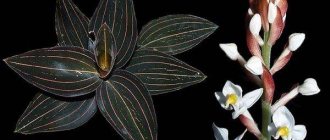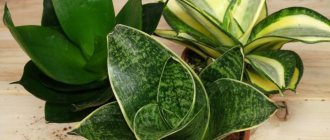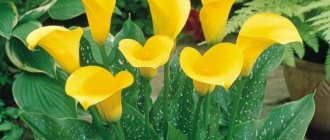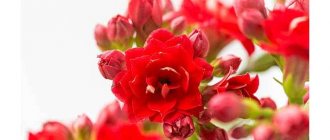There are many varieties of orchids. This flower is rightfully considered one of the most beautiful. Different types of orchids have delicate flowers that can come in a wide variety of colors. Many gardeners are attracted to this flower, despite the difficulties in care.
How many varieties of orchids are there? On average, there are about twenty thousand varieties of orchids, which also include hybrid varieties. But each flower is unique, and in this article we will tell you about them. The article will also contain pictures and photos of plants: this will help you get to know this wonderful flower better.
What does Ludisia look like?
Ludisia is often called the “precious” orchid because it has a rare quality difference - its leaves are not inferior in beauty to its flowers. Most often these are velvety dark green sheets with beautiful silver stripes.
Sometimes these can be dark leaves with a burgundy tint with light veins. The color of the leaves most often depends on the light they consume and the variety of ludisia.
Photos of the Ludisia orchid will greatly surprise you, because you will not see the usual lush flower. On a stem no more than 30 centimeters long you can see something similar to a miniature orchid. These are about 20 flowers on one stalk, the diameter of which reaches only 2 centimeters.
The flower itself is a composition of small white petals and a pronounced yellow stamen.
Types of lycastes
Virgin, or Skinner's (virginalis) is one of the most beautiful plants in the genus. A pair of ovoid leaves is formed from the pseudobulbs. The peduncles grow up to 25–35 cm, and white-pink fragrant flowers about 15 cm in circumference form on their crown. The lip is three-lobed with a slight yellowness or pure white or with barely noticeable crimson to purple streaks and small polka dots. It blooms throughout the month from late autumn to early winter, but the peak of active bud formation occurs from January to mid-spring. Thanks to its long peduncles, the orchid is used for cutting. Hybrids of Japanese selection are especially popular among flower growers, for example, lycasta sakura with short leaves and a large pink flower with a diameter of up to 9 cm, in the creation of which the breeding material of this species was used for 80% and 6–7% each from the types of lycasta large-leaved, blood-red and krinites.
Virgin, or Skinner's (virginalis)
Short-winged (brevispatha) is a compact plant with peduncles shorter than the leaves. The sepals are greenish in color, sometimes with pink dots and tips bent back. The petals are snow-white with a slight pale pink tint. The lip has a weakly defined three-lobed outline, white, occasionally with barely visible light pink specks.
Short-winged (brevispatha)
Aromatica (aromatica) is one of the most popular lycastes in indoor floriculture with yellow-orange flowers that exude a subtle spicy aroma. Two varieties are known: one with small flowers with a circumference of no more than 4–6 cm, narrow sepals and anterior lip blade, the second with larger flowers with a diameter of up to 8 cm, with wide perianth lobes.
Aromatica
Cochleata - with small yellow flowers about 4 cm in circumference and a characteristic expressive swelling at the base of the lip, steeply curved downwards. Blooming flowers smell like chocolate.
Cochleata
Blood red (cruenta) is a small orchid with short flower stalks, cinnamon-scented flowers at the top located below bright green oval leaves. It is not clear on what basis the name was given to the species, because the flowers of the plant are orange-yellow, and the red spot at the very base of the lip is visible only if you look closely. The sepals are yellow-emerald in color and are effectively bent back. Flowering in this species lasts for one and a half months, and leaf fall occurs once every 2–3 years.
Blood red (cruenta)
Macrophylla is a large plant up to 70 cm high with thick ovoid pseudobulbs almost 10 cm high and 3–6 cm in diameter in cross section, often flattened on the sides and several longitudinal grooves. From the tops of the pseudobulbs, 2–3 fan-shaped leaves are formed, 45 to 75 cm long, which fall off at the beginning of winter. The peduncles are short, no more than 18–20 cm, with one flower at the top, large and fragrant. The color of the sepals varies from olive greenish and light brown to dark chocolate. The petals and lip are white, often with small pinkish, scarlet or purple small polka dots. Peak flowering is in May, but often forms flower stalks at other times of the year.
Macrophylla
What types of ludisia are there?
All varieties of this plant have approximately the same flowers. Lydisia orchid can vary in leaf color and size, as well as its size. Today there are the following types:
- Dawsoniana - the leaves have a deep green color, which can be called black, the veins on the leaf have a red tint
- Rubrovenia - leaves have a beautiful bronze color with beautiful copper stripes
- Ordiana - classic appearance - dark green leaves with silver stripes
- Trilineata - large leaves in copper shades
- Grandis - large leaves in a classic color
- Condorensis - has a tall stem on which flowers grow
- Otletae - narrow leaves in red shades
History of origin
The Multiflora orchid is an exclusively hybrid plant; it is the painstaking work of breeders over many years.
Note: in nature you can find orchids in mountain forests and at the foot of cliffs, enjoying truly unique views.
A wild orchid does not have such a colorful variety of colors compared to a hybrid.
How to care at home
All special conditions that must be created are directly related to where the plant comes from. The Ludisia orchid came to us from the tropics, which means that several important factors must be taken into account:
Temperature. This plant is accustomed to temperature changes. Ludisia is comfortable with an average temperature of +25 during the day, +20 at night. That is, at night she will be comfortable near a window with an open window.
Light. On a summer day, this plant loves shade, and in winter it needs additional lighting. Most importantly, you should avoid bright sunlight; soft, diffused light is ideal for ludisia.
Humidity. Ludisia loves humidity, however, unlike other plants, spraying it with water from a spray bottle can have unpleasant consequences.
Drops of water leave “scars” on the leaves that cannot be eliminated. An excellent way out of the situation would be to have a regular bowl of water that will stand next to this flower.
Watering. Ludisia loves humidity, but water should not be allowed to stagnate in the pot. Water for irrigation should be at room temperature, preferably pre-settled.
Cumbria
The Cambria orchid is not found in nature. The plant is a hybrid of three orchids. The flowers have a variety of shapes and also differ in size. But the flower stalks themselves need support. It is best to place the orchid on the windowsill. The leaves are located on pseudobulbs - growths. The length of the leaf plates is 40-50 centimeters, and they have an elongated shape. In summer, it must be protected from direct sunlight. In winter, the plant needs lighting at night. You also need to monitor the watering schedule, since the plant needs moisture in the winter season.
Cumbria
Reproduction methods
Ludisia seeds are not so easy to find, and only experienced specialists can grow an orchid from them. Therefore, the following methods are used to propagate ludisia:
- division: to separate a stem with three or more shoots from an adult plant
- cuttings: cut off the top with 2-3 nodes, process and root
About flowering
If optimal conditions are created for the plant, the desired temperature is maintained, normal lighting and watering are provided, then buds will appear continuously and year-round. In other situations, most likely, you will only be able to admire flowers from mid-autumn until the end of winter.
To find out if Cambria is going to shoot arrows, you need to examine its pseudobulbs. Before the start of the phase, they fill with juice, swell a little and seem to stop growing. After this, the buds are activated in the sinuses and a peduncle appears. The last one exists for no more than 2 months, but after it another one is formed and so on - constantly.
When the buds fall, the pseudobulb also dries up, but at its base another bud is formed, from which a little later a young sprout hatches.
The orchid does not require any special care after flowering. It is only necessary to reduce the intensity of watering (by about a third) and remove dead shoots. In very dry air, it is advisable to additionally spray the plant with water.
Advice: we recommend increasing the volume of liquid no earlier than the newly formed shoots have stretched to approximately 30 mm.
If Cambria does not want to bloom, you will have to stimulate it. To do this, you should take care to reduce the temperature at night to +13 °C…+15 °C.
There is another way - during the period of active formation of pseudobulbs, watering is halved. After a week, the irrigation intensity is restored, and after another 7 days it decreases again. All this causes the orchid to throw out its peduncle.
Such methods cannot be used on young plants - it is better to give them time to fully develop.
Threats and diseases
All diseases of this plant are a consequence of improper care. The most common threats:
- rot: if it appears, check how to water the flower correctly and what is the watering rate for your type of ludisia - the formation of rot indicates that there was more than enough water
- white mold: forms on the ground if there is not enough fresh air in the room
- wrinkled leaves: indicate that the orchid is sorely lacking water
- burns on the leaves: they say that the orchid is in direct sunlight and needs to find a more shady place
- spider mites, aphids, whiteflies: growing at home is not often accompanied by the occurrence of such pests, but if the room is too hot and low humidity, the likelihood of their appearance is high
Peculiarities
There are several characteristic features that distinguish Cambria from other orchids. First of all, it is worth mentioning the shoot type of growth, which is completely atypical for most members of the family.
The next feature is that the roots of the hybrid do not participate in photosynthesis, that is, they do not require light, but they need breathable soil placed in an opaque pot to receive nutrients.
And finally, a flower. The petals are pointed, their number is 5. The lip is strongly developed, rounded, often contrasting.
Advice: do not rush to replant a newly purchased plant. Let it bloom and adapt to new living conditions.
Ludisia transplant
The description of the flower suggests that it is not prone to intensive growth in height. Ludisia most often grows as a beautiful bush horizontally. The root system of the flower also behaves. That is why low but wide pots and cache-pots are chosen for ludisia.
As soon as the orchid has stopped growing, this means that the plant is becoming cramped in its pot and it is time to replant. As a rule, this happens once every few years.
It is better to transplant ludisia in the spring. To make it gentle on the plant, you can take soil as a substrate and mix it with peat.
Description
Cambria belongs to the sympodial orchids, which are characterized by a horizontal direction of growth. Simply put, it behaves like a grapevine.
Vertical shoots stop developing at the end of the growing season. Horizontally located parts ensure the formation of the root system.
With the onset of a new period of development, fresh lateral shoots are formed, which in turn produce pseudobulbs. The latter are usually used for propagation of Cambria. Their shape, depending on the variety, can be spindle-shaped, oval or elongated.
Pseudobulbs produce up to 2 peduncles (they produce buds only once, and then die), as well as leaves. The plates are lanceolate, narrow, appressed. The length of some hybrids reaches up to 50 cm. Their structure is dense, juicy, with a leathery surface and a pronounced central vein. Typically the leaf color is deep green.
Flower sizes vary greatly, but the largest often reach a diameter of 100 mm. The shape of the buds is characteristic of all varieties - they resemble five-pointed stars. The color of the petals is very diverse.
The most common colors are as follows:
- golden;
- pink;
- crimson;
- beige.
There are also variegated orchids, in which the mentioned shades are intricately combined with white and others.
The roots of Cambria are very thin, ensuring the stability of the orchid. At the end of the life cycle of pseudobulbs, they die, but new ones are formed almost immediately on the young shoot.
Pruning Ludisia
Ludisia is a compact plant that does not require growth control or intervention in the form of pruning. However, sometimes this is a necessary measure.
Indoor care may require pruning only if during the period when the orchid is still forming. If you notice that the stem with the flower has begun to grow too rapidly and this has noticeably deteriorated the quality of the leaves, you need to remove it. This will help save the plant from inevitable death.
Ludisia is one of the most unusual types of orchids; it always stands out with its non-standard appearance against the background of other plants. If you love orchids and know in what conditions to keep this indoor plant, be sure to add it to your collection.
Cattleya
This type of orchid is distinguished by bright flowers that look like corrugated paper. Cattleya is the largest plant species. However, not all specimens are gigantic in size; there are also mini orchids. When purchasing, you can choose a color for yourself, as well as choose a convenient size. If you want to grow a plant indoors, then focus on hybrid varieties, as they are much easier to care for. Cattleya blooms from spring to autumn, the flowers are on the plant for three weeks. Once the flowering period is over, the orchid must be left alone for 6-7 weeks. During this period, you need to water the plant very carefully so as not to create an excess of moisture. It is best to place the pot on the sunny side so that it does not lack natural light. From time to time you need to wipe the leaves with a damp sponge. An orchid can be identified by the large growths on which the leaves are located.
Cattleya











